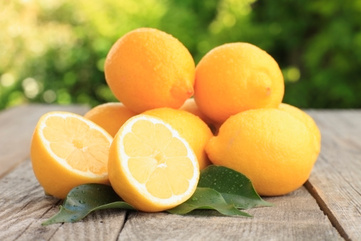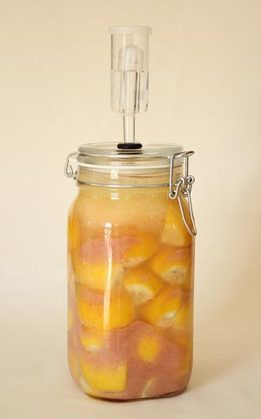
Ingredients:
12 organic lemons* 1/2 Cup Himalayan Pink Salt** Jar: 1 Liter Jar (or double the recipe in a 2 Liter Jar) Brine: None Ferment: 14 days at room temperature (68-72ºF) 
Preparation:
Organic lemons are absolutely necessary because they do not have wax on their skins. Lemons with waxed skins will not ferment. **Preserving/Lacto-fermenting lemons is a little different than a vegetable; they already have high acid, and we're using such a high salt content that very little LAB activity is going to take place, and at a much slower pace. The spoiling microorganisms on lemons are very hardy and low pH resistant, and such a high salt content is necessary to prevent spoilage, even in The Probiotic Jar. Since the salt content is so high, and the LAB activity so low, we aren't going to consider this a "healing" food, but it sure is good! There seems to be enough LAB that when the brine and flesh of these lemons are added to other foods such as lacto-fermented mayonnaise or Ranch Dressing the shelf life of those foods is considerably extended. Deliciously! Please add your comments below!
7 Comments
Karen
11/6/2015 06:35:09 pm
We are making a fermented hot sauce of habaneros and preserved grapefuit. I'm assuming that the liquid from the grapefruit will act as a good starter for fermenting the peppers. What do you think?
Reply
George
8/20/2018 01:36:34 pm
How did you get on with this ? I want to make habanero hot sauce this year also
Reply
Karen
8/20/2018 02:05:27 pm
Hello George,
Carol Rosenberg
5/6/2018 02:29:04 pm
i'm not at home, but i think my organic lemons said they have beeswax coating; will that work?
Reply
Karen
5/6/2018 02:47:14 pm
I would gently wash the wax off with warm water. Don’t soak the lemons, as you want to preserve the oil in the skin.
Reply
Carol K McMorrow
11/23/2019 10:01:45 am
Can you provide more information about how to proceed after step 10 in the recipe? How long do I keep the jar at room temperature before moving to the refrigerator, or do I need to refrigerate this at all? When are the lemons ready to use?
Reply
Karen
11/23/2019 01:51:52 pm
Hello Carol,
Reply
Leave a Reply. |
Recipe ListHere you will find the most delicious, health-boosting concoctions on planet earth! You are sure to experience both a delightful sensation on your taste buds as well as a happy tummy!
Beets, (Grated) with Clove, Cinnamon & Allspice Beet Kvass Brussel Sprouts Berry Syrup/Sauce Carrots (Grated) with Chocolate Mint Cabbage Juice Carrots & Beets with Rosemary & Thyme Carrot Sticks (Herbed or Plain) Carrot (Grated) with Chocolate Mint Carrots, Leeks, Ginger & Dill Dandelion Buds Dill Pickles (Traditional) Fire Cider Garden Medley Kvass Garlic Ginger, Shaved & Pickled Ginger, Beet & Kale Kvass Ginger Soda Ginger Bug (Starter) Granola Green Beans Lemons Mayonnaise Ranch Dressing Salsa ~ Chunky Tomato Sauerkraut Sauerkraut Juice Turmeric Root Tonic ~ Cold, Sinus & Flu Categories
All
How ToThe success of every recipe shared on this site is dependent on the proper application of anaerobic pickling techniques. These recipes are designed specifically to work in The Probiotic Jar. Please follow the instructions in the Quick Start Guide when creating these recipes. Archives
January 2016
|
 RSS Feed
RSS Feed
